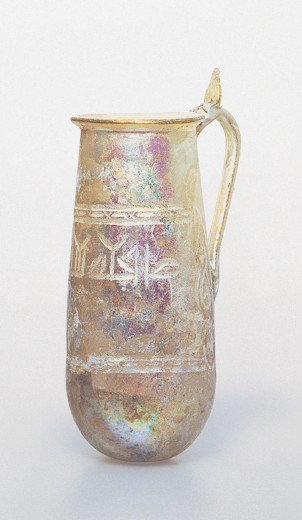



Title: Jug
Date: 9th–10th century AD
Location: Iraq or possibly Nishapur, Iran
Materials: colourless glass; blown, with trailed-on handle, tooled, bevel- and linear-cut
Dimensions: 17.7 x 8.4cm
Accession Number: GLS 179
Other Notes:
The sack-like shape of this jug is unusual and is rarely found in Islamic glass. It resembles the askos form well represented in Greek and Roman vessels, and is somewhat reminiscent of a leather water-skin. Moreover, the combination of two cutting techniques in its decoration – namely linear in the horizontal strokes and bevelled in all others – is also rare.
The vessel has a long, sub-cylindrical body with a markedly everted rim and a rounded base. The pontil mark has been ground down, but it is still visible. The heavy trailed and tooled handle has a flattened, almond-shaped thumb-rest.
The main decoration on the body consists of a bold Kufic inscription reading ‘afiyah shafiyah (‘curing health’). The inscription is framed above and below by paired grooves with bands of oval notches between, separated by incised x-motifs. These framing bands stop short of the handle, which itself is framed with a bevel-cut guilloche band terminating in a stylized palmette emerging from a vase placed immediately below the handle. Some of the letters of the inscription and the filling of the palmette are cross-hatched.
Bibliography:
S.M. Goldstein et al, Glass. From Sasanian Antecedents to European Imitations, The Nasser D Khalili Collection of Islamic Art, volume XV, London 2005, cat.198, pp.166–7.
Zoom
Close

Create your own collection of artworks that you can print or save as a PDF. Please enter you email to enable feature.
Small Flask | JLY 1075
Has been added to your collection.
TIP:
You can now access and view your collection from the main menu at any time.